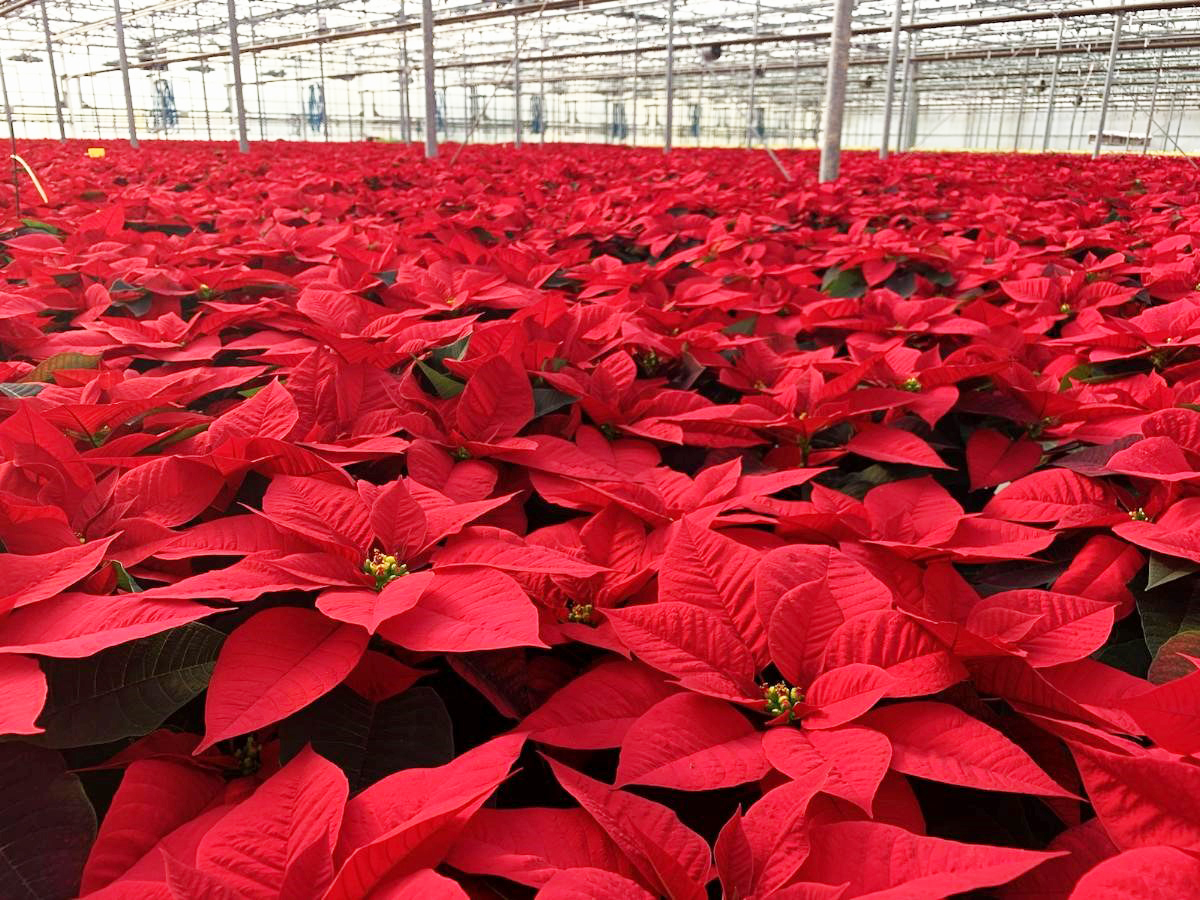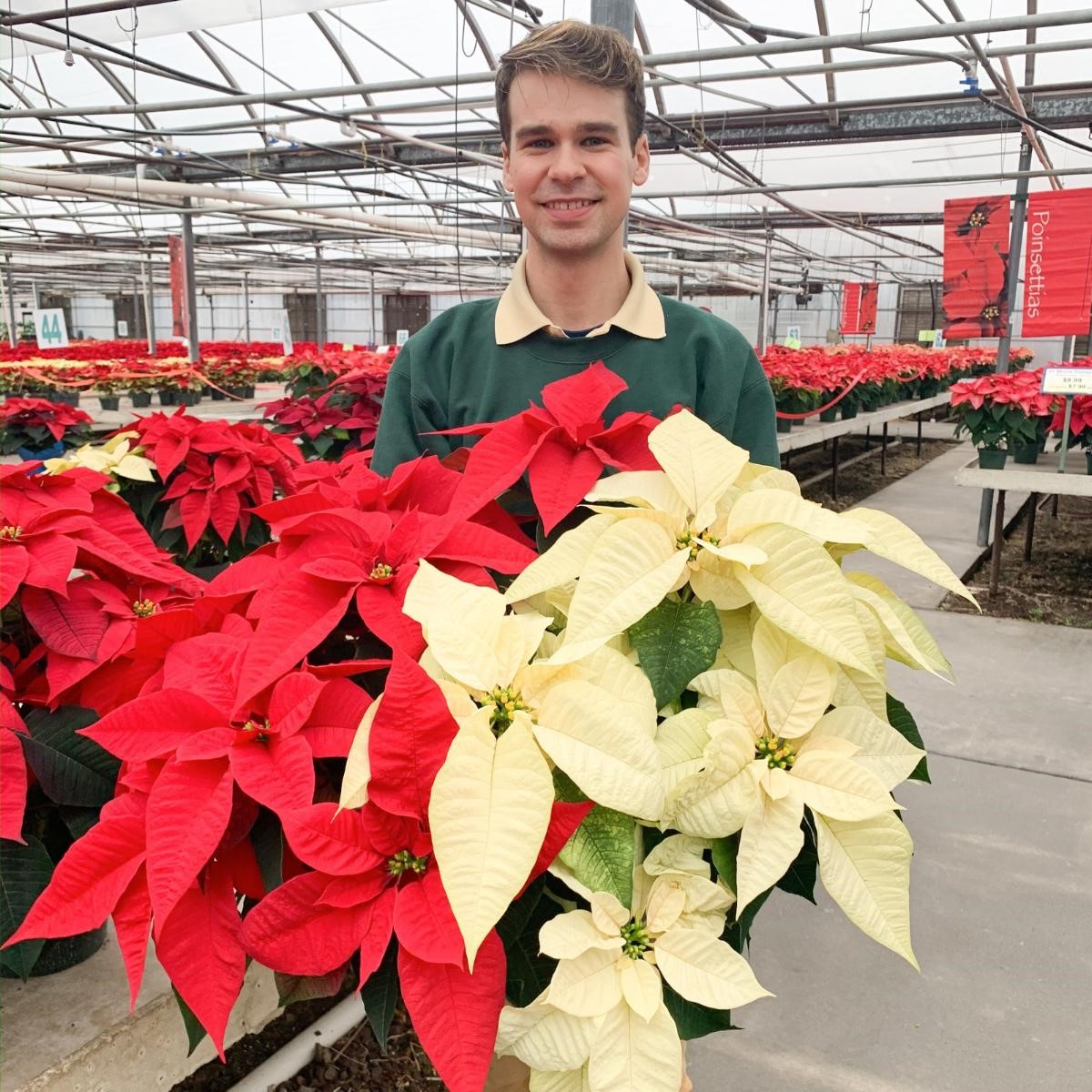Poinsettia Care

Our traditional holiday plant was brought to this country by the U.S. Minister to Mexico, Joel Roberts Poinsett, in 1835.
He returned to South Carolina with cuttings of this pretty Mexican wildflower. It still bears his name. Much plant breeding has produced the superior plants we grow today.
CHOOSING A PLANT
1. Make sure the poinsettia you choose was not sitting to close to the door of the store, where they are continually exposed to both warm and cold air. Poinsettias do not do well with cold air, as they are a tropical plant.
2. Look at the foliage. Does it look healthy? Are the inner bracts a solid color, or are they showing some green? If they are starting to show some green, that means the plant is almost done flowering.
3. Last, but certainly not least, make sure you place your poinsettia in a sleeve or put another bag over top of it before you leave the store to prevent your new poinsettia from freezing on the way to the car.
POINSETTIA CARE
1. Place in bright light (natural or artificial). Since these are tropical plants, poinsettias thrive in a lot of sunshine. If you place your poinsettia in a window, make sure it is not touchnig the glass, as it could be quite cold.
2. Avoid cold drafts or excessive heat from television sets, radiators, or heating ducts.
3. Water thoroughly when the surface soil feels dry. However, make sure that you allow excess water to drain off, as they do not like wet feet. If the foil liner does not allow your plant to drain freely, we recommend cutting the foil so it will drain. Make sure you are checking your poinsettia regularly for watering as indoor air in the winter can be quite warm and dry.
4. Temperature should not exceed 75 degrees F. The low can be 60 degrees F.
ARE POINSETTIAS TOXIC?
For years, poinsettias have had the bad reputation of being poisonous. They certainly are not meant to be eaten by humans, pets, or livestock, and ingesting a large amount of poinsettias would probably cause some stomach upset, as would eating almost any houseplant. However, poinsettias have undergone extensive testing, and there is no evidence that they are toxic or unsafe to have in the house. They are also safe to put into the compost. While this popular Christmas plant is not toxic, be sure to use care when handling your poinsettias. The plant family the poinsettias are in, Euphorbias, exude a milky sap when broken. Many are sensitive to this sap, which can cause an itchy rash. To prevent this, try washing your hands after handling a poinsettia plant and avoid pinching or pruning with your hands.
POINSETTIAS AS CUT FLOWERS
1. Place stem 6-8” long into boiling water for 1 to 2 minutes. Then place into cool water.
2. Make final cut in area treated. The boiling water keeps the latex in the stem from hardening and blocking the stem from taking up water. Holding the stem over a flame may be used in place of hot water, but it is less successful.
KEEPING A POINSETTIA
Although it’s unlikely that our potted poinsettias will ever achieve the grandeur of those grown outdoors in the subtropics, with a little care, they can become long-lasting houseplants, living to bloom again during future holiday seasons. As with any houseplant, choosing a healthy specimen makes subsequent care much easier. Look for a well-proportioned, compact plant with dense, vigorous, dark-green foliage on strong, stiff stems. The bracts, or colored, petal-like leaves that surround the small, yellowish true flowers, should be well developed and fully colored to assure lasting color for the holiday season.Chilly winds or temperatures below 50 degrees F will severely shock a poinsettia, causing it to drop its leaves, so protect your plant on the way home by placing it in a large shopping bag or a sleeve of paper or plastic.
CARE DURING THE HOLIDAYS
Place your poinsettia near a sunny window where it will receive about six hours of bright light each day. Avoid cold, drafty spots and those with hot afternoon sun and temperatures much above 70 degrees, since too much heat makes the bracts fade. Also keep the plants away from the drying heat of a furnace or fireplace.Like most other houseplants, poinsettias do best in moist but not soggy soil. When the soil surface feels dry, water until moisture begins to seep through the drain holes. Discard any excess water that collects in the saucer, because a plant left sitting in water may develop root rot, which can be fatal.
PRUNE
When the bracts begin to fade, usually in late March or April, cut back the stem (or stems) so that the plant is about 8” tall. This pruning helps keep the plant from becoming overly tall and leggy. You might want to wear rubber gloves during this process, since the milky sap that oozes from the cut stems can irritate sensitive skin.
SUMMER CARE
In early June, when new growth is well underway, gently transplant the poinsettia into a pot an inch or two larger than the original one. Water the plant thoroughly and return it to its sunny window, or move it outside to a warm, sunny spot sheltered from drying winds. Continue to water and fertilize regularly over the summer. It’s a good idea to pinch the new growth back by an inch or two in July to keep the plant compact. Pinch again in late August if growth is vigorous. If the plant spends the summer outdoors, be sure to bring it back inside before the cool nights of autumn arrive. Sometimes a poinsettia attracts insect pests; whiteflies are a particular threat. Spray with an insecticide soap as soon as your spot any signs of trouble, repeating the treatment as needed.
REFLOWERING: STARTING SEPTEMBER
Poinsettias are photoperiod plants, setting flower buds as the nights become longer. But the artificial lights in our homes upset this natural cycle. So, starting in mid-to late September, you will have to intervene to make sure your poinsettias get around 14 continuous hours of darkness each night. This can be accomplished either by covering the plant with a cardboard box or a black plastic garbage bag, or by placing it in a dark closet. If you place it in a closet, be sure absolutely no light is getting to it, through cracks in the door or if the closet is used. If any light shines on the poinsettia during this time, it will affect the bud set. Take care that the poinsettia doesn’t get too cold during these long nights—temperatures should stay between 60 and 70 degrees. Uncover or retrieve the plant each morning and return it to a sunny window. Water every few days as needed, and fertilize as before. Continue to provide this long-night, short-day regimen for eight to ten weeks, or until small bracts begin to show fall color. At that point, you can bring the plant back into normal household lighting fulltime. The bracts will mature and develop, providing a colorful holiday decoration once again.
